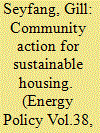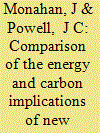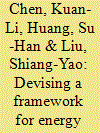|
|
|
Sort Order |
|
|
|
Items / Page
|
|
|
|
|
|
|
| Srl | Item |
| 1 |
ID:
177140


|
|
|
|
|
| Summary/Abstract |
As coalbed methane, the natural gas adsorbed in coal seams, is a greenhouse gas that is 21 times stronger than CO2, coalbed methane extraction significantly influences carbon reduction and energy conservation efforts. While the injection of CO2 into coal seams is known to effectively enhance coalbed methane recovery, this process has been limited because of high investment and production costs. Therefore, to promote the application of CO2 injection techniques in coalbed methane industry, this paper proposes an authority–enterprise equilibrium based mixed subsidy mechanism which combines direct subsidies with indirect tax-incentives. Specifically, a multi-objective bi-level programming model is established under uncertainty to assign a practical constraint and achieve a trade-off between the local authority and the coalbed methane plants. A practical case validates the feasibility and efficiency of the proposed method, proving that an authority–enterprise equilibrium based mixed subsidy mechanism is able to achieve carbon emissions reductions and conserve energy. Further analysis indicated that the marginal energy efficiency gains were greater than the authority costs under a strict energy utilization policy and that the environmental protection target had larger impacts on the coalbed methane plant performances.
|
|
|
|
|
|
|
|
|
|
|
|
|
|
|
|
| 2 |
ID:
101425


|
|
|
|
|
| Publication |
Amsterdam, Elsevier, 2010.
|
|
|
|
|
|
|
|
|
|
|
|
|
|
|
|
| 3 |
ID:
101455


|
|
|
|
|
| Publication |
2010.
|
| Summary/Abstract |
This paper presents a new analytical framework of 'grassroots innovations' which views community-led initiatives for sustainable development as strategic green niches with the potential for wider transformation of mainstream society. This framework is applied to a low-carbon, low-impact, community-based sustainable housing initiative in the USA that pioneers straw bale housing techniques within a strong community-building ethos. The project is evaluated according to New Economics criteria of sustainable consumption, and is found to be successful at localising the construction supply chain, reducing ecological footprints, community-building, enabling collective action and building new institutions and systems of provision around housebuilding. However, viewing it as a strategic niche with aim to influence wider society, it is clear that it faces significant challenges in diffusing its ideas and practices beyond the niche. Its model is not necessarily suitable for scaling up or widespread replication; however, the scope for niche lessons to be adopted by mainstream builders is greater, given a supportive policy environment. Recognising the innovative nature of green niches at the policy level could lead to new approaches to governance of bottom-up community action for sustainable development.
|
|
|
|
|
|
|
|
|
|
|
|
|
|
|
|
| 4 |
ID:
101401


|
|
|
|
|
| Publication |
2011.
|
| Summary/Abstract |
The built environment needs to develop sustainable, decarbonised, low energy systems and approaches that are socially acceptable and economically beneficial. The UK mainstream house construction industry is being driven, through policy and regulation, towards achieving this end without evidence of how these new systems of provision are used by passively adopting households. In this paper energy use, consequential emissions of CO2, and annual running costs for a case study comprising 14 newly constructed low energy affordable homes are evaluated. Four different energy typologies are compared: ground sourced heat pumps; active solar (thermal and photovoltaic); passive solar and mechanical ventilation with heat recovery; conventional high efficiency gas boiler. The carbon embodied in construction and emitted over a 20 year occupation period for each typology is calculated. Ground source heat pumps have the highest annual primary energy demand, CO2 emission and annual running costs over the 20 year period. The homes with active solar technologies provided most benefit across all three evaluation criteria. Energy and CO2 emissions associated with end uses other than heating were similar to the UK average. This poses significant questions on the probability of policy application in the real world to deliver projected reductions in emissions of CO2.
|
|
|
|
|
|
|
|
|
|
|
|
|
|
|
|
| 5 |
ID:
119814


|
|
|
|
|
| Publication |
2013.
|
| Summary/Abstract |
Research has indicated that incorporating carbon reduction in the curriculum could improve awareness about energy conservation and related practices. Much research has been conducted on curriculum design and evaluation methods for energy education. However, a comprehensive view of the educational objectives for improving energy literacy is still lacking in these efforts. In this study, we propose a framework for energy education that clearly captures the concept of energy saving and carbon reduction by reviewing related literature and consulting an ad hoc panel of experts on energy and education. We then apply the analytic hierarchy process (AHP) to determine the indicators of the framework and their priority or weights. The results show that the dimensions of "civic responsibility for a sustainable society" and "low-carbon lifestyle" are considered most important as an energy educational goal. Among the indicators, "awareness and self-efficacy" and "identifying carbon-less technology and action plans" are ranked first and second. Application of this framework in K-12 curriculum and relevant educational issues are recommended.
|
|
|
|
|
|
|
|
|
|
|
|
|
|
|
|
| 6 |
ID:
105775


|
|
|
|
|
| Publication |
2011.
|
| Summary/Abstract |
Households are expected to play a pivotal role in reducing the UK's greenhouse gas (GHG) emissions, and the UK Government is encouraging specific household actions to help meet its targets. However, due to the rebound effect, only a portion of the GHG emission reductions estimated by simple engineering calculations are generally achieved in practice. For example, replacing short car journeys by walking or cycling reduces consumption of motor fuels. But this frees up money that may be spent on, for example, purchasing extra clothes or flying on vacation. Alternatively, the money may be put into savings. Since all of these options lead to GHG emissions, total GHG savings may be less than anticipated. Indeed, in some instances, emissions may increase-a phenomenon known as 'backfire'. We estimate that the rebound effect for a combination of three abatement actions by UK households is approximately 34%. Targeting re-spending on goods and services with a low GHG intensity reduces this to a minimum of around 12%, while re-spending on goods and services with a high GHG intensity leads to backfire. Our study highlights the importance of shifting consumption to lower GHG intensive categories and investing in low carbon investments.
|
|
|
|
|
|
|
|
|
|
|
|
|
|
|
|
|
|
|
|
|